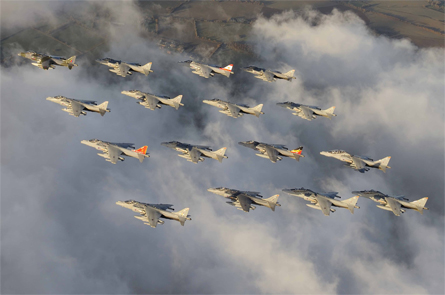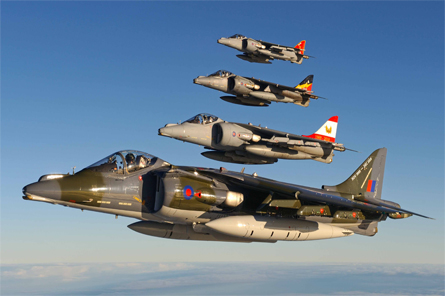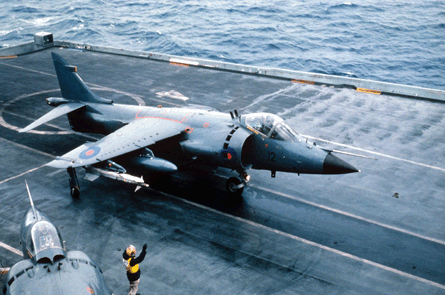Operations with the UK’s BAE Systems Harrier GR9/9A ground-attack aircraft will come to an end today, with the nation’s Joint Force Harrier organisation to perform a final series of sorties from the Royal Air Force’s Cottesmore base in Rutland.
The farewell is to involve a 16-aircraft formation which will perform flypasts at the RAF’s facilities at Wyton, Cranwell, Waddington, Scampton and Coningsby and also over Stamford, Lincoln and Oakham before returning to land at Cottesmore. The aircraft should take off from around 13:15 local time and land around 90min later, the Ministry of Defence says.
 |
|---|
© Jamie Hunter/Aviacom |
In total, 13 single-seat aircraft and three two-seat trainers were involved in rehearsal flights conducted earlier this week.
One of the aircraft has been painted in a retrospective colour scheme previously used with early RAF versions of the Harrier, as shown in this image from Aviacom photographer Jamie Hunter. Three others are shown with their tail fins painted to mark their operation by the RAF’s 1 and 4 squadrons, and by the Royal Navy Fleet Air Arm’s 800 NAS.
 |
|---|
© Jamie Hunter/Aviacom |
Each of the units operated Harrier GR7A/9As from Kandahar airfield in Afghanistan in support of the NATO-led International Security Assistance Force over an almost five-year period ending in mid-2009. The type was replaced in theatre by the RAF’s Panavia Tornado GR4 strike aircraft after more than 8,500 sorties and 22,000 flight hours.
Operations with the UK’s Harriers were due to have continued until at least 2018, when it was to have transitioned to Lockheed Martin’s short take-off and vertical landing F-35B. However, the nation’s coalition government in late October announced a decision to retire the current type by 31 March 2011, and to shift the UK’s planned production commitment to the Joint Strike Fighter programme to the F-35C carrier variant.
The UK had already reduced the size of its Harrier ground-attack fleet over the last several years, but Flightglobal’s MiliCAS database says the type’s early retirement still leaves around 52 aircraft as surplus to requirements. This includes 28 recently upgraded GR9s and 16 GR9As – the latter version is powered by Rolls-Royce’s uprated Pegasus 107 engine – plus eight T10/12/12A two-seat trainers.
One of the jet age’s most iconic designs, the Harrier was first flown in prototype form in 1960, as the Hawker Siddeley P1127. The UK’s “Jump Jet” achieved legendary status with its pivotal role during the 1982 Falklands War, when the RN’s newly-fielded Sea Harriers shot down numerous Argentine air force aircraft.
 |
|---|
© John Jockel/Rex Features |
The then-British Aerospace also collaborated with McDonnell Douglas to develop the AV-8B Harrier II. MiliCAS says more than 140 of these remain in service with the US Marine Corps, with the Italian and Spanish navies also operating the type. The Indian navy also flies eight Sea Harrier FRS51 fighters and three trainers.
Today’s event in the UK marks the nation’s second Harrier retirement in less than five years, with the Ministry of Defence having retired the RN’s last Sea Harrier FA2s in March 2006.
Flightglobal Defence Editor Craig Hoyle flew in Harrier trainer ZH659 in 2006. Read his report here
Source: FlightGlobal.com























